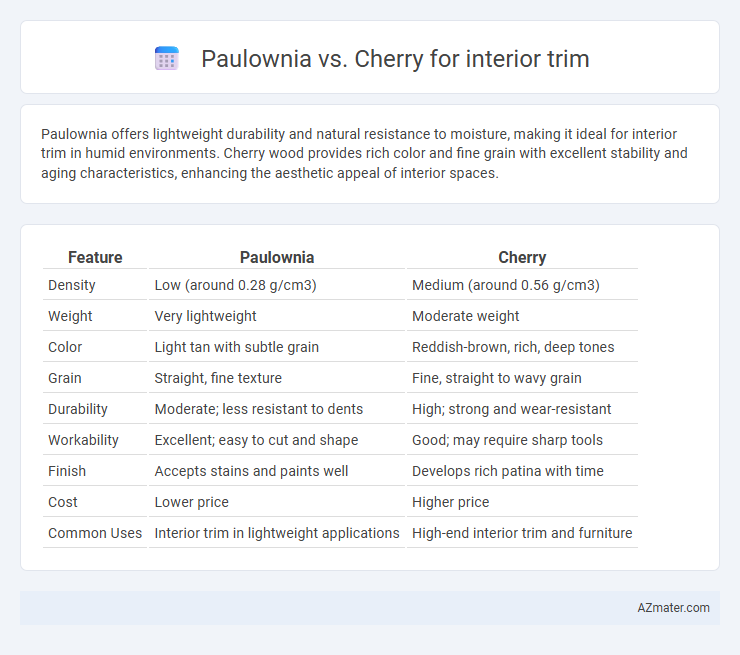Paulownia offers lightweight durability and natural resistance to moisture, making it ideal for interior trim in humid environments. Cherry wood provides rich color and fine grain with excellent stability and aging characteristics, enhancing the aesthetic appeal of interior spaces.
Table of Comparison
| Feature | Paulownia | Cherry |
|---|---|---|
| Density | Low (around 0.28 g/cm3) | Medium (around 0.56 g/cm3) |
| Weight | Very lightweight | Moderate weight |
| Color | Light tan with subtle grain | Reddish-brown, rich, deep tones |
| Grain | Straight, fine texture | Fine, straight to wavy grain |
| Durability | Moderate; less resistant to dents | High; strong and wear-resistant |
| Workability | Excellent; easy to cut and shape | Good; may require sharp tools |
| Finish | Accepts stains and paints well | Develops rich patina with time |
| Cost | Lower price | Higher price |
| Common Uses | Interior trim in lightweight applications | High-end interior trim and furniture |
Introduction to Paulownia and Cherry Wood
Paulownia wood, known for its lightweight and smooth texture, offers excellent stability and resistance to warping, making it ideal for interior trim applications where dimensional consistency is crucial. Cherry wood boasts a rich, warm reddish-brown color that deepens with age and exposure to light, providing a classic and elegant look favored in high-end trim and cabinetry. Both woods provide unique benefits: Paulownia excels in durability and ease of finishing, while Cherry is prized for its aesthetic appeal and natural sheen.
Key Characteristics of Paulownia
Paulownia wood is lightweight yet strong, exhibiting a straight grain with a smooth texture that makes it ideal for interior trim. Its natural resistance to warping and shrinking surpasses that of cherry, ensuring long-lasting stability in varied indoor environments. The pale color of Paulownia also offers versatile finishing options, allowing for customization that complements diverse design styles.
Key Characteristics of Cherry Wood
Cherry wood features a rich, warm reddish-brown color that deepens with age and exposure to light, providing a luxurious and elegant look for interior trim. It is known for its smooth texture and fine, straight grain, making it easy to work with and ideal for detailed moldings and finishes. Compared to Paulownia, cherry is significantly denser and harder, offering superior durability and resistance to dents and scratches in high-traffic areas.
Aesthetic Appeal and Color Comparison
Paulownia wood offers a light, creamy tone with a subtle grain pattern that provides a modern, airy aesthetic for interior trim, contrasting with Cherry's rich, reddish-brown hue that deepens over time, lending warmth and traditional elegance. Cherry's natural aging process enhances its deep, luxurious color, while Paulownia maintains a stable, pale coloration ideal for bright, minimalist interiors. Both woods provide unique aesthetic appeals, with Cherry suited for classic, sophisticated designs and Paulownia favored for contemporary, light-filled spaces.
Durability and Strength Differences
Paulownia wood is significantly lighter and less dense than cherry, resulting in lower strength and durability for interior trim applications. Cherry offers superior hardness and resistance to wear, making it more suitable for high-traffic or impact-prone areas. While paulownia may suit decorative elements due to its workability, cherry's robust nature ensures longer-lasting trim with better structural integrity.
Workability and Ease of Installation
Paulownia offers superior workability for interior trim due to its lightweight and soft texture, allowing for easy cutting, sanding, and shaping compared to the denser and harder cherry wood. Cherry wood, while more durable and resistant to wear, requires sharper tools and more effort during installation, potentially lengthening project time. The ease of installation with Paulownia can lead to faster completion and fewer tool-related challenges, making it a practical choice for DIY or quick interior trim projects.
Cost Analysis: Paulownia vs. Cherry
Paulownia wood offers a cost-effective alternative to cherry for interior trim, typically priced 30-50% lower due to its faster growth rate and abundance. While cherry provides superior durability and rich color tones that enhance long-term value, Paulownia's lightweight and lower resin content reduce labor costs during installation and finishing. Budget-conscious projects often favor Paulownia for its affordability without sacrificing the aesthetic warmth found in cherry trims.
Sustainability and Environmental Impact
Paulownia wood offers a highly sustainable option for interior trim due to its rapid growth rate, carbon sequestration capabilities, and minimal pesticide requirements compared to traditional hardwoods like cherry. Cherry wood, while durable and aesthetically pleasing, grows slowly and often involves more intensive forestry practices, increasing its environmental footprint. Utilizing paulownia reduces deforestation pressure and supports eco-friendly building practices by promoting renewable, low-impact materials.
Maintenance and Longevity
Paulownia wood offers lightweight durability with low maintenance, resisting warping and insect damage, making it ideal for interior trim in humid environments. Cherry wood, known for its rich color and fine grain, requires periodic polishing to maintain its aesthetic appeal but offers superior longevity due to its density and hardness. Both woods age beautifully, with Cherry developing a deep patina over time, while Paulownia retains its structural integrity with minimal upkeep.
Best Applications for Interior Trim
Paulownia wood is ideal for interior trim applications requiring lightweight, moisture-resistant materials, making it perfect for decorative moldings and window casings in humid environments. Cherry wood offers a rich, warm appearance with fine grain and excellent durability, best suited for high-end interior trim like baseboards and door frames where aesthetic appeal is prioritized. Both woods perform well, but Paulownia excels in moisture-prone areas, while Cherry is preferred for its classic beauty and hardness in living spaces.

Infographic: Paulownia vs Cherry for Interior trim
 azmater.com
azmater.com